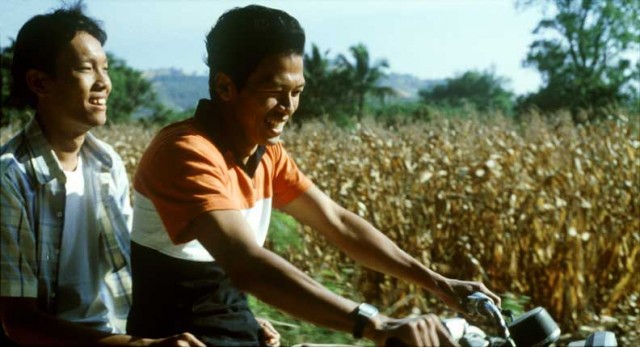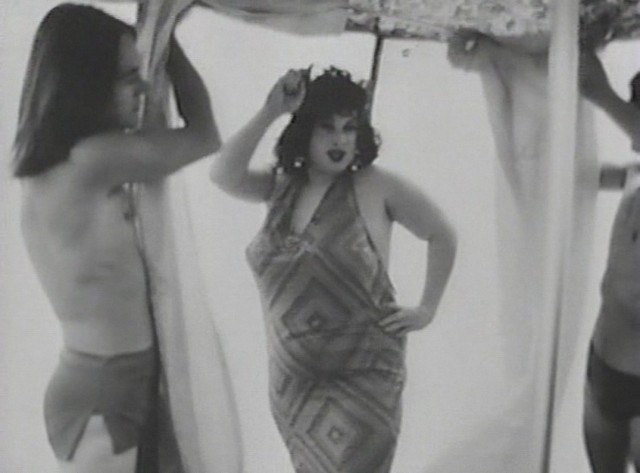MULTIPLE MANIACS (John Waters, 1970),
Museum of the Moving Image
35th Ave. at 36th St., Astoria
Friday, June 28, 7:00
Series continues through July 6
718-777-6888
www.movingimage.us
 In conjunction with the fiftieth anniversary of the Stonewall riot, the Museum of the Moving Image is presenting “Grit and Glitter: Before and After Stonewall,” a thirteen-film series guest curated by Donal Mosher and Michael Palmieri (October Country, Peace in the Valley) consisting of queer-cinema works that have inspired them. The seventeen-day festival began with such films as Jack Smith’s Flaming Creatures, Tony Richardson’s A Taste of Honey, and Pier Paolo Pasolini’s Teorema and continues June 28 with one of John Waters’s craziest early works, when the King of Bad Taste, serving as writer, director, producer, cinematographer, and editor, was only twenty-three. The extremely low budget romp Multiple Maniacs begins with barker Mr. David (David Lochary) inviting people into Lady Divine’s Cavalcade of Perversions, proclaiming, “This is the show you want. . . . the sleaziest show on earth. Not actors, not paid imposters, but real, actual filth who have been carefully screened in order to present to you the most flagrant violation of natural law known to man.” Of course, that is an ideal introduction to the cinematic world of Waters, one dominated by the celebration of sexual proclivities, fetish, salaciousness, indecency, violence, and marginalized weirdos living on the fringes of society. Lady Divine, played by Divine, turns out to be a cheat, the freak show just a set-up for a robbery. Soon Divine is jealous of David’s relationship with Bonnie (Mary Vivian Pearce), hanging out with her topless daughter, Cookie (Cookie Mueller), and being led into a church by the Infant of Prague (Michael Renner Jr.), where she’s brought to sexual ecstasy by Mink (Mink Stole). There’s also rape, murder, Jesus (George Figgs), the Virgin Mary (Edith Massey), and the famed Lobstura. Shot in lurid black-and-white, Multiple Maniacs is a divine freak show all its own, an underground classic that redefined just what a movie could be, a crude, disturbing tale that you can’t turn away from.
In conjunction with the fiftieth anniversary of the Stonewall riot, the Museum of the Moving Image is presenting “Grit and Glitter: Before and After Stonewall,” a thirteen-film series guest curated by Donal Mosher and Michael Palmieri (October Country, Peace in the Valley) consisting of queer-cinema works that have inspired them. The seventeen-day festival began with such films as Jack Smith’s Flaming Creatures, Tony Richardson’s A Taste of Honey, and Pier Paolo Pasolini’s Teorema and continues June 28 with one of John Waters’s craziest early works, when the King of Bad Taste, serving as writer, director, producer, cinematographer, and editor, was only twenty-three. The extremely low budget romp Multiple Maniacs begins with barker Mr. David (David Lochary) inviting people into Lady Divine’s Cavalcade of Perversions, proclaiming, “This is the show you want. . . . the sleaziest show on earth. Not actors, not paid imposters, but real, actual filth who have been carefully screened in order to present to you the most flagrant violation of natural law known to man.” Of course, that is an ideal introduction to the cinematic world of Waters, one dominated by the celebration of sexual proclivities, fetish, salaciousness, indecency, violence, and marginalized weirdos living on the fringes of society. Lady Divine, played by Divine, turns out to be a cheat, the freak show just a set-up for a robbery. Soon Divine is jealous of David’s relationship with Bonnie (Mary Vivian Pearce), hanging out with her topless daughter, Cookie (Cookie Mueller), and being led into a church by the Infant of Prague (Michael Renner Jr.), where she’s brought to sexual ecstasy by Mink (Mink Stole). There’s also rape, murder, Jesus (George Figgs), the Virgin Mary (Edith Massey), and the famed Lobstura. Shot in lurid black-and-white, Multiple Maniacs is a divine freak show all its own, an underground classic that redefined just what a movie could be, a crude, disturbing tale that you can’t turn away from.
“The outrageously subversive Multiple Maniacs could easily be mistaken as mere freak show sentiment and gross-out comedy, but at heart it’s a defiantly angry rejection of all things mainstream,” Palmieri explains in a program note. “Shot in the summer of Stonewall in Baltimore in 1969 and released in 1970, the film begins with Mr. David installed on a quiet wooded suburban street luring unsuspecting passersby to dare to attend Lady Divine’s Cavalcade of Perversion, in which all hell breaks loose. The audience is made complicit in this transgression, and appropriately assaulted for it for the rest of the production. As punk and queer as film gets.”

Apichatpong Weerasethakul’s Tropical Malady was both booed and celebrated at the 2004 Cannes Film Festival
TROPICAL MALADY (SUD PRALAD) (Apichatpong Weerasethakul, 2004)
Museum of the Moving Image
35th Ave. at 36th St., Astoria
Saturday, June 29, 7:00, and Sunday, June 30, 2:00
Series continues through July 6
718-777-6888
www.movingimage.us
 “Grit and Glitter: Before and After Stonewall” takes quite a turn from Multiple Maniacs with Thai director Apichatpong Weerasethakul’s Tropical Malady, a beautiful, mystical work that won the Jury Prize at Cannes and will thoroughly engage you — if you allow it to. Part tender love story between a country boy (Banlop Lomnoi) and a soldier (Dakda Kaewbuadee), part folktale set in the deep forests of Thailand, Tropical Malady is like a visual poem in which details are not as important as the overall effect, which is intoxicating. The unorthodox film features ghosts, a shape-shifter, unusual characters, and a playful sense of humor that come together to form a subtle meditation on life and love. Weerasethakul once again displays the gentle, captivating narrative technique that lies at the heart of his oeuvre, which also includes such works as Blissfully Yours, Syndromes and a Century, and 2010 Palme d’Or winner Uncle Boonmee Who Can Recall His Own Lives. Some people at Cannes walked out on Tropical Malady and others stuck around to boo it; Quentin Tarantino headed the group that awarded it the Jury Prize regardless. You can decide to cheer or boo, or merely just experience it, when it screens on June 29 and 30 at the Museum of the Moving Image.
“Grit and Glitter: Before and After Stonewall” takes quite a turn from Multiple Maniacs with Thai director Apichatpong Weerasethakul’s Tropical Malady, a beautiful, mystical work that won the Jury Prize at Cannes and will thoroughly engage you — if you allow it to. Part tender love story between a country boy (Banlop Lomnoi) and a soldier (Dakda Kaewbuadee), part folktale set in the deep forests of Thailand, Tropical Malady is like a visual poem in which details are not as important as the overall effect, which is intoxicating. The unorthodox film features ghosts, a shape-shifter, unusual characters, and a playful sense of humor that come together to form a subtle meditation on life and love. Weerasethakul once again displays the gentle, captivating narrative technique that lies at the heart of his oeuvre, which also includes such works as Blissfully Yours, Syndromes and a Century, and 2010 Palme d’Or winner Uncle Boonmee Who Can Recall His Own Lives. Some people at Cannes walked out on Tropical Malady and others stuck around to boo it; Quentin Tarantino headed the group that awarded it the Jury Prize regardless. You can decide to cheer or boo, or merely just experience it, when it screens on June 29 and 30 at the Museum of the Moving Image.
“Blissfully beyond categorization, Apichatpong Weerasethakul’s breathtaking Tropical Malady is a sui generis romance told in two parts: a gentle courtship between two men that transforms into a mind-altering tale of a soldier stalked by a shaman in the form of a tiger,” Palmieri writes. “Mysterious on just about every level possible, Apichatpong explores the complicated nuances of desire through this magical and haunting parable, where playful evasiveness eventually gives way to total surrender. Come for the love story, stay for the talking monkey.”
The series runs through July 6 with such other films as Sidney Lumet’s Dog Day Afternoon, Stephen Frears’s My Beautiful Laundrette, and Pietro Marcello’s The Mouth of the Wolf. “Being a rural gay kid, my source of queer presence and history mostly came from viewing media stereotypes and news reports about AIDS — save for the rare films that were illuminated windows into a queer world happening, waiting, and calling from the other side,” Mosher notes. “Since then I’ve spent my life seeking and, hopefully, on occasion, creating such illuminated moments. We now live in a time when LGBTQ+ representation is so mainstream that the Stonewall riot can be rewritten as a triumph of whiteness and the life of Freddie Mercury can be retooled to support normative family values. To me, though, the films in this program shine with a disruptive, beacon-like power. Some are celebratory, some problematic. Some are highly crafted, some crudely made. Some are all of these things, which is why the light they radiate is not a single reductive beam but a necessary iridescence — multifaceted, shifting, reflecting the visions of both vast communities and the single, lonely viewer in the dark.”
Palmieri adds, “With this series, we’re interested in the films and filmmakers whose ideas reflected the cultural shifts bubbling under the surface that led to Stonewall, as well as the effect it had on the cinema and culture that followed. In these films you’ll find a multitude of approaches, even contradictions, but they all share a subversiveness, a strain of rage, a rejection of social and cinematic norms, and a deep well of empathy. These films are clarion calls to me as a filmmaker, and they serve as a constant reminder that rage and empathy can coexist, and that they are powerful tools to work with.”
